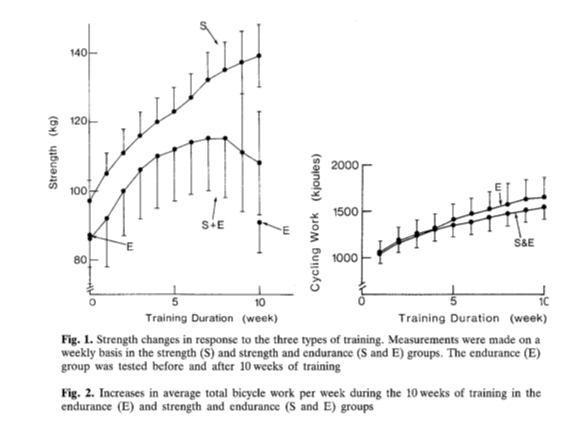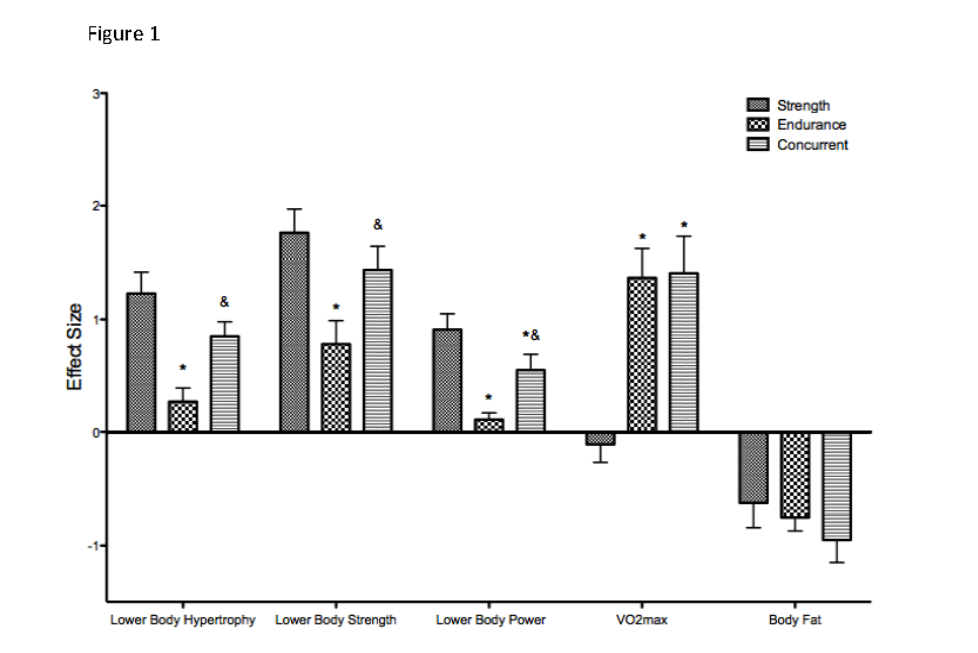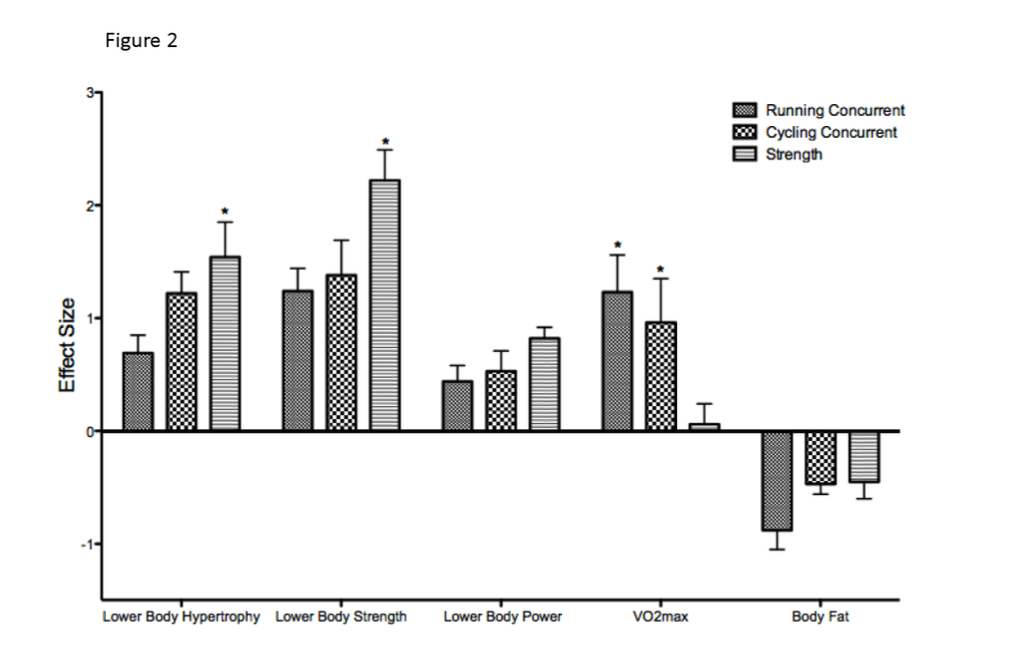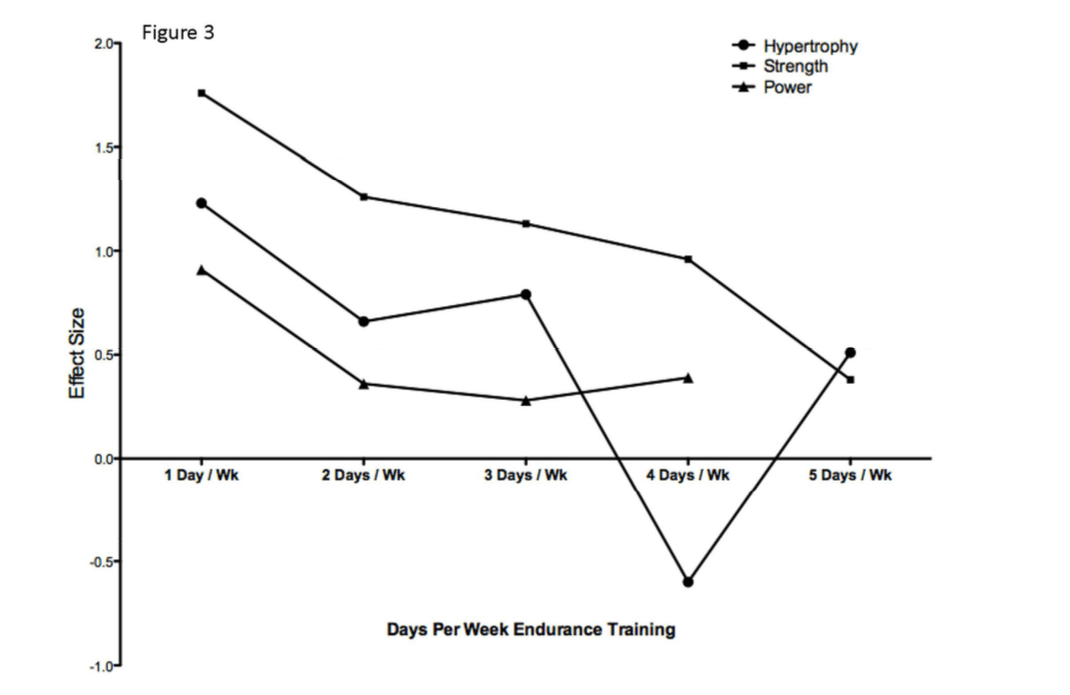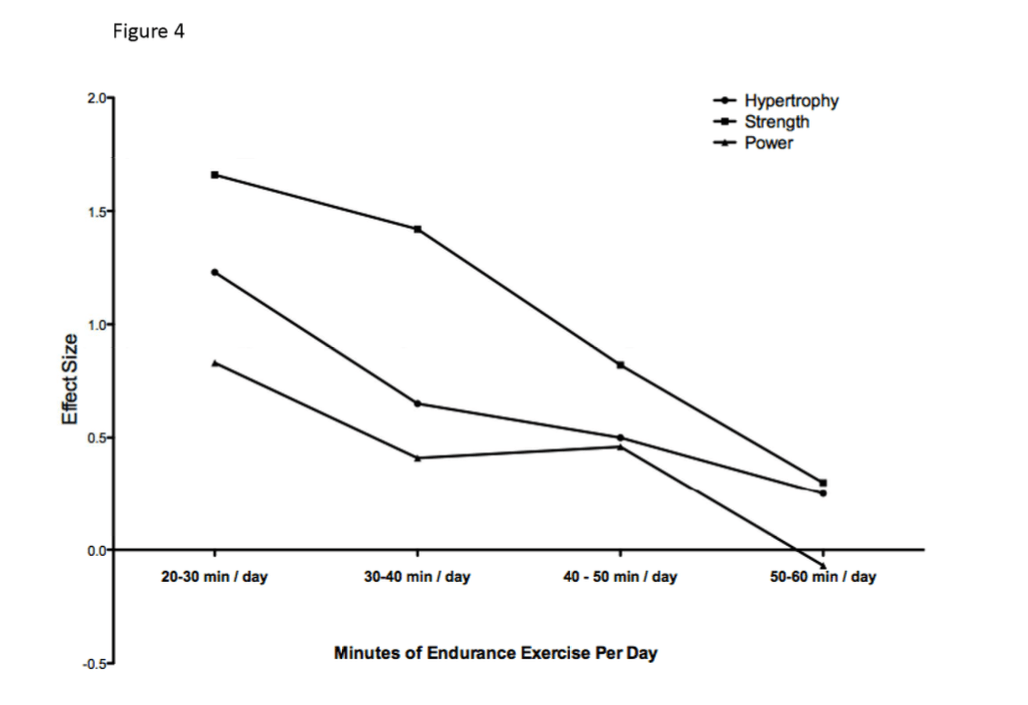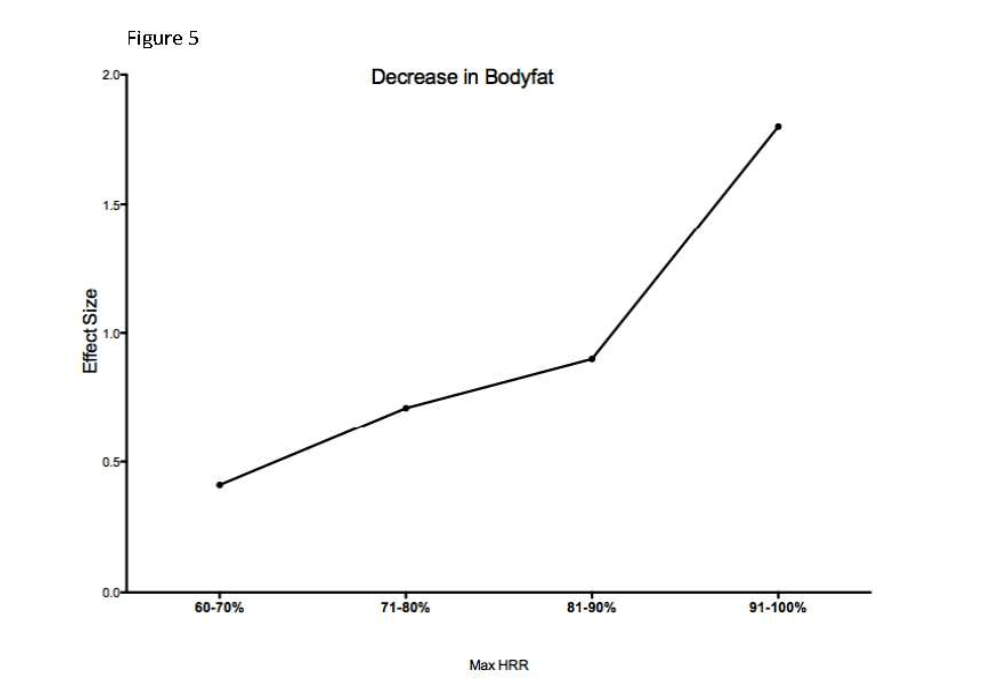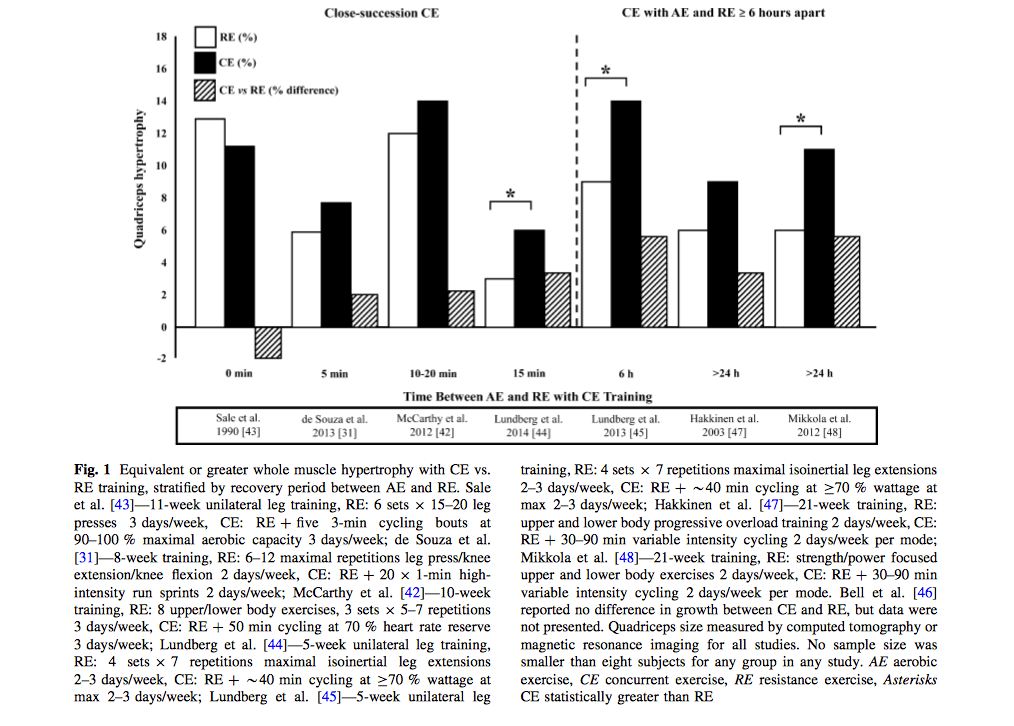Note from Greg: This article comes from my good friend Cody Haun. Cody was the first coach we hired here at Stronger By Science, and he’s now finishing up his PhD in Kinesiology at Auburn University. This article (the first part in a two-part series on concurrent training) provides a thorough but accessible overview of the concurrent training research, while future installments will focus more on mechanisms and implementation.
Introduction to Concurrent Training
Concurrent training refers to a training session or program that includes some form of “endurance” exercise and “resistance” exercise. Practically, when someone mentions concurrent training, they are generally referring to the combination of lifting weights and cycling, rowing, swimming, or running on a regular basis, and within the same training session, on the same day, or within the same training program. The details that go into planning a concurrent training plan become more relevant when specific programming strategies are considered in specific scenarios, particularly when the degree of interference between two modes is a concern. Attempting to balance cardio and strength training isn’t anything new. In fact, history tells us that one of the first formal arguments in exercise science in America was related to this very topic. Further, I’m confident many of you have discussed this topic at least once with training partners, friends, or foes prior to reading this article. I’ve personally been a part of or overheard heated exchanges in classrooms and weight rooms over the years pertaining to this topic. So, is concurrent training bad for a powerlifter? What does scientific research suggest regarding the effects of concurrent training on skeletal muscle growth or improving strength?
A Brief Primer on Concurrent Training Research
I like defining words. I also want us to be on the same page about what specifically I’m referring to in this article. So, I’d first like to provide some operational definitions. For this article, my operational definition of concurrent training is: physical training involving lifting weights to improve hypertrophy or strength combined with other physical activities to improve aerobic metabolism capacity or metabolic characteristics within the same training session, on the same day, or within the same training program.
For clarity, here are two additional operational definitions:
1) Endurance training: repetitive or continuous physical exercise primarily involving body mass alone and gravity as resistance utilizing chiefly aerobic metabolism to complete a predetermined amount of work (e.g., > 5 minutes).
2) Resistance training: physical training involving the movement of external loads through space with predetermined movement patterns for the purpose of building or maintaining muscle mass, improving strength, or enhancing power.
Given the intention of this section and length constraints of the article, it simply wouldn’t be possible to review every relevant concurrent training study. For the interested reader, however, please refer to the following citations and the articles that I specifically discuss below for more information (2-4).
The concept of training specificity and practicing whatever you want to be good at more often than other modes of physical training is not a new concept (e.g., endurance versus strength training). Therefore, I won’t spend too much time telling you that training specificity is important.
However, I would like to note that, generally speaking, it is a great idea to primarily train the ability which you are seeking to improve (or a close relative thereof) throughout most of the macroscopic training structure (i.e., macrocycle). For example, from a macrocycle perspective, if you are wanting to get better at running 1600 meters, running more than lifting weights will likely result in more favorable outcomes. Conversely, if you are wanting to maximize squat strength, squatting more than other training modes – particularly modes like running or other forms of conditioning – will likely result in more favorable outcomes. Simply mind-blowing content, right? In reality, however, the details of dosing training of any kind become more important the more trained one becomes in either ability (i.e., endurance or strength). Further, if peak performance at specific time points is the ultimate intention of all training, understanding appropriate management of training dosage and variation is critical.
Given the vast number of athletic endeavors this article could discuss when considering the number of different fitness abilities and scenarios in which some form of concurrent training applies, please allow me to clarify the focus. The remainder of this article will primarily focus on individuals wanting to increase and/or maintain: a) strength, and b) muscle size.
I’m assuming that if you’re reading this, you already appreciate that training with heavy loads often, and heavier loads at some point soon thereafter, is the most foolproof, time-tested way to get stronger (i.e., specificity and overload). Unfortunately, doing those two things in training are not best applied linearly, and specific dosages become more difficult to appropriately apply the stronger one becomes (8-15). With that said, this is not an article focused on periodization and training principle application, although certainly related, and this is something that Greg and I will be writing more about in the future. We’ve known for a very long time that becoming as strong as possible requires lifting heavy – and eventually heavier weights – in a progressive manner. So, can regular completion of “cardio” or conditioning, if you are concurrently trying to make involved musculature bigger or stronger, really rob your gains? Let’s see what some of the most relevant research in this area suggests in this primer section.
The first formal scientific investigation comparing adaptive effects of concurrent training to the more singularly focused training of the past century occurred in 1980.
In 1980, Dr. Robert Hickson conducted a study with three groups of subjects:
- A strength training only group (S) that lifted 5 days per week for 10 weeks (n = 8).
- An endurance training only group (E) that trained 6 days per week, in which subjects ran 3 days per week and cycled 3 days per week (n = 8).
- A group performing both the strength and endurance training protocols (SE) with anywhere from 15 to 120 minutes between bouts of training (n = 7).
Dr. Hickson described the design of the strength training as “exclusively to increase leg strength.” Sessions primarily involved sets of 5 repetitions in the “parallel squat” (5 x 5), “knee extensions” (3 x 5), and “knee flexions” (3 x 5). It is stated that deadlifts were also performed, along with sit-ups, but it is unclear in what set-rep manner and at what intensity.
For the previously described exercises, subjects were instructed to lift “as much weight as possible,” and are said to have started the 10-week training period with 80 % 1RM for all lifts, with the weight for each movement being increased “to maintain maximal resistance for the required repetitions.” Three-minute rest intervals between working sets were allowed throughout the study.
Regarding the endurance training, subjects trained 6 days per week. Three days per week, subjects cycled on an ergometer with intervals of 5-minutes at a work-rate that “approached the subjects’ VO2max,” separated by 2-minute rest intervals. On the other three days, subjects performed “continuous running as fast as possible” on a treadmill for 30 minutes during week 1, 35 minutes during week 2, and 40 minutes every week thereafter.
The SE group performed both of the above training protocols. Importantly, as mentioned prior and related to points in the section below, periods between bouts of training were anywhere from 15 to 120 minutes in this group. Thus, the duration between endurance and strength training bouts was not standardized in the SE group. As likely already clear to most of you, the SE group underwent quite a vigorous training program in comparison to the other groups. Collectively, they were training 6 days per week, twice per day. Interestingly, while S and SE group members were tested in squat strength every week, the E group was only tested before and after the experiment, resulting in a lack of clarity of the weekly effects of endurance training on subject squat strength.
Now, you know that this would be a really long article if each relevant study were discussed. Luckily, many of the same points I’d make in reference to other pertinent studies can be made just referencing this one. So, to be pithy, I’ll mainly discuss this investigation and two meta-analytical articles that suffice to make important points. A quick statistical power analysis warrants caution in the extrapolation of these data to the population in its capacity to be translated and applied on a broad scale. Since this is just one study with a relatively small sample size, we should be careful in our interpretation and translation to practice. However, data from these “hypothesis-generating” studies are still valuable and can be employed for meta-analyses or review articles wherein many smaller sample studies that meet certain criteria are combined or pooled into an analysis resulting in significantly larger sample sizes from which more population-level inferences can be made. Now, let’s unpack Dr. Hickson’s data.
Data from Dr. Hickson’s work can be, and certainly have been, interpreted in a variety of ways. Please refer to the two figures from the manuscript below and take a moment to interpret them from your perspective.
Derived from (5).
Some of you might say the data indicate that the group concurrently training did not improve strength as much as subjects only strength training. Correct. Notably, although raw data are not provided, the group strength training only started at a higher level of strength than the concurrent group, and when modeling these data controlling for baseline metrics, it would be interesting to see changes in each ability. That is, did stronger individuals or more endurance-trained individuals suffer greater decrements or realize more or less improvement from isolated training compared to concurrent training? We can’t say without seeing Dr. Hickson’s raw data.
Other readers might say the SE group did not improve aerobic fitness as much as the E group. Correct.
Interestingly, these are the types of interpretations one can make from basically every concurrent training study greater than 6 weeks that I’ve investigated when both fitness variables are measured (i.e., metric of strength and metric of aerobic fitness). However, I’ll offer an additional interpretation and then segue into more recent work from other authors in way of not being redundant.
The degree and rate of strength improvement in the S and the SE group were largely the same through 7 weeks of training (~20kg increases in squat 1RM) (5). Regarding the subjects, the manuscript states that “…none had been training on a regular basis for at least 3 months prior to the start of the exercise programs.” Consequently, the magnitude of strength and/or endurance improvement in this study does not necessarily translate to trained individuals. Considering the above interpretations, the figures above, and the other tables and data in the manuscript collectively, an equally fair interpretation is that a relatively safe window of time or mesocycle length during which abilities can be concurrently enhanced or trained without significant decrements in another ability seemingly exists in untrained subjects (e.g., ~6 weeks).
Another fair interpretation of these data is that the S group actually realized numerical improvements, albeit minor (~5%), in VO2max measured during treadmill running (i.e., the maximum amount of oxygen inspired and utilized by the body during an exercise test). That is, strength training in untrained subjects for 10 weeks may not reduce VO2max, and actually might improve this metric by ~5%, according to Dr. Hickson’s investigation. Indeed, others have shown improvements in VO2max after a period of strength training. Further, select training studies demonstrating decrements in either ability often test at inappropriate times to demonstrate positive effects (i.e., the delayed training effect), or employ inappropriate training designs to actually improve either or both abilities demonstrably at the testing time point (e.g., periodization modeling and programming), as beautifully highlighted in the following citation from Bazyler et al. (16).
Although employing a suboptimal form of hypertrophy assessment via thigh girth measurements, Hickson’s data also indicate significant improvements in quadriceps size in both the concurrent training and strength training only groups (~2cm), with no significant change in the endurance group. So, concurrent training actually resulted in increases in thigh size and squat strength, along with significant improvements in VO2max. Further, the concurrent training group lost ~2% body fat after 10 weeks of training while not losing a significant amount of body weight, whereas the strength training only group did not lose a significant amount of body fat and gained ~2kg of body weight.
To summarize these alternative interpretations of Hickson’s data before moving on, key points are outlined below:
- Concurrent training for a period of 6 weeks did not mitigate significant improvements in either strength or endurance, and improvements were similar to the groups training with a singular focus.
- Strength training alone did not reduce VO2max and actually numerically improved it by ~5%.
- Concurrent training resulted in similar increases in thigh size as strength training only after 10 weeks of training.
- Concurrent training resulted in greater losses in body fat than strength training only.
Although certainly helpful and a landmark study in its own right, the above Hickson example is only one study, and it was performed in apparently untrained subjects. As previously alluded to, let’s briefly examine a meta-analysis and a review article considering virtually all well-controlled concurrent training studies since.
In 2012, Wilson et al. published a thorough meta-analysis examining the hypothetical interference effect of endurance and strength training (17). The authors provided effect size calculations for strength training only, endurance training only, or the combination of the two training types on the following dependent variables: 1) lower body hypertrophy, 2) lower body strength, 3) lower body power, 4) VO2max, and 5) body fat. Additional effect size calculations provided included the stratification of effects on these variables when the endurance training was primarily running versus cycling, compared to strength training alone. Further, authors provided insightful analytical data on the effect sizes stratified based on the number of days per week, and the duration of the bouts of endurance exercise on the previously described dependent variables. Authors also provided a figure wherein the magnitude of decrease in body fat is plotted against the average intensities of endurance exercise. To provide clarity, below is my interpretation of the question each figure in the manuscript sought to answer:
- Overall, what effects do endurance training alone, strength training alone, and the combination of the two training types have on lower body hypertrophy, lower body strength, lower body power, laboratory-measured VO2max, and total body fat?
- Are the effect sizes on these dependent variables different if endurance training occurs on a cycle versus running?
- Are the effect sizes on these dependent variables different as a function of the number of days per week endurance training occurs?
- Are the effect sizes on these dependent variables different as a function of the duration of each bout of endurance training?
- Is the effect size of endurance training intensity on body fat meaningful?
I’ll provide my brief interpretation of the figures below each figure, but these views do not necessarily represent the opinions or views of the authors of the manuscript. Before viewing the figures, I’d first like for you to consider that the bars signifying hypertrophy and strength are indicative of an increase in muscle size or strength, with a maintenance of these parameters being visualized as no change. That is, positive effect sizes for hypertrophy and strength below should be interpreted as improvements in these parameters, by definition.
The nature of the effect size calculation in this meta-analysis dictates that a pre-mean score (i.e., before a training intervention) be subtracted from a post-mean score (i.e., after an intervention) and then divided by the overall variation in scores at baseline (e.g., pooled standard deviation at pre). In an elegantly simple way, an effect size approximates the effect of a treatment or intervention on a dependent variable, and these effect sizes can be compared among groups performing different types of training to identify comparatively smaller or larger effects. My main reason for highlighting this is that a smaller effect size, if positive, should be interpreted as an improvement in the metric.
As you’ll see, qualitatively, exercise of any type enhanced muscle size, strength, and endurance in the > 20 studies from which effect sizes were calculated, regardless of training design (i.e., S, E, or SE). So, although to an absolutely lesser extent than strength training alone, concurrent exercise and endurance exercise actually resulted in improvements in muscle power, size, and strength in the studies employed for this analysis.
As additional key points related to training periodization, fitness characteristic decay rates, and particularly training variation, overall effect sizes from this thorough meta-analysis indicate that neither concurrent training nor endurance training alone resulted in decreases in muscle size, strength, or power, in that the effect sizes were positive.
Stated in another way, concurrent training or endurance training alone resulted in numerical increases in lower body muscle size, lower body strength, and lower body power. Conversely, strength training alone resulted in numerical decreases in VO2max. In my opinion, this is a crucial point for anyone interested in training programming of any kind.
A few considerations/limitations to this interpretation should be noted: a) many of the studies used to calculate effect sizes employed untrained individuals; b) effects may be, and likely are, different in highly specialized individuals, and careful training approaches are thus encouraged; and c) little empirical evidence is available on more complex training structures involving undulating, concentrated workload programming wherein doses of different training types are manipulated to elicit specific peaks in select fitness characteristics (e.g., block periodization, phase potentiation, etc.), warranting a cautioned interpretation of the magnitudes of expected changes in hypertrophy, power, or strength when considering various training approaches.
Intriguingly, the effect size for strength in trained individuals was actually numerically larger when individuals concurrently trained compared to when individuals only strength trained (2.13 versus 2.12 in Table 2 of the manuscript). Even if we are pedantic about the number of significant digits in an effect size, one can state that trained individuals who concurrently trained improved strength to the same extent as trained individuals who completed strength training alone (i.e., 2 versus 2, with rounding).
Finally, for anyone who skipped all of the above writing, a brotastic description of this meta-analysis indicates that endurance exercise combined with strength training or endurance training alone didn’t result in the robbery of dem gainzz. Please take a moment to interpret the figures for yourself.
Derived from (17).
Lower body hypertrophy, strength, and power improvements were greatest in subjects performing only strength training. In contrast, VO2max improved by approximately equal magnitudes in subjects performing endurance training alone when compared to subjects performing concurrent endurance and strength training. Also, subjects concurrently training lost more body fat than subjects training with singular foci, albeit not statistically significant.
Derived from (17).
Strength training only remained the most powerful improver of hypertrophy and strength when comparisons were made to endurance training separated into running-based or cycling-based conditioning modes. However, albeit not statistically significant, cycling resulted in numerically greater improvements in lower body hypertrophy, strength, and power. Additionally, running improved VO2max to a greater extent than cycling, while also resulting in greater losses of body fat.
Derived from (17).
This figure beautifully illustrates that the more days per week someone endurance trains, the greater the likelihood, on average, that the amount of muscle gained and amount of improvement in strength will be decreased. However, related to the points above, a positive effect size indicates an improvement, even if to a lesser extent.
Derived from (17).
Following along with Figure 3, the greater the duration of the bouts of endurance training, the lower the improvement in muscle size, strength, and/or power. Critically, however, improvements in muscle size and strength were still made even when endurance training was completed for 50-60 minutes per day.
Derived from (17).
Intriguingly, authors discovered that the higher the percent of HRR (i.e., HRR = Max HR – RHR) at which endurance training occurred, on average, the greater the losses in body fat. Caution: Managing fatigue, particularly in strong individuals or individuals with a lot of muscle mass, when undertaking high-intensity conditioning can be complicated and can easily interfere with overloading sessions in the weight room. Hence, cogent thought should precede application of this type of training for the high-level powerlifter.
In 2016, Dr. Kevin Murach and Dr. James Bagley published a very interesting, Current Opinion article in Sports Medicine titled: “Skeletal Muscle Hypertrophy with Concurrent Exercise Training: Contrary Evidence for an Interference Effect” (18). Some of the molecular biology presented in this manuscript, along with biological data from other research, will be discussed in the next article of this series. However, the authors visualized hypertrophic effects of concurrent training from well-controlled studies in the primary figure of the manuscript, warranting discussion in this article. Check it out:
Derived from (18).
Summary
Again, my interpretations of these data do not necessarily reflect the views of the authors. With that said, and in line with many of the points made by Murach and Bagley, these data indicate that quadriceps hypertrophy occurs to a greater extent, in general, when concurrently training aerobic and resistance exercises. Furthermore, so long as at least a 5-minute break is provided between exercise types, this effect seems to dominate the literature. Additionally, starting at hour 6 after a bout of resistance exercise, greater hypertrophic outcomes seem more probable. You may be asking the following:
- So, concurrent training results in greater muscle hypertrophy?
- Why does the break between exercise types seem to augment hypertrophy?
- What specific physiology is involved?
- What are the practical implications from these data?
- So, should powerlifters concurrently train?
These are all great questions. To be clear, I am by no means stating that concurrent training is more effective than more singularly focused training for muscle hypertrophy or improving strength. Furthermore, answers to these questions and specific mechanisms underlying these observations are not entirely clear. However, research from the past two decades has provided a lot of insight and allows evidential training methods to avoid potentially negative effects of concurrent training. I do hope that you’ll take some time to ponder these data and read the follow-up article, which will provide an evidence-led discussion of some of the molecular biology and more specific information regarding the practical application of concurrent training, or consideration thereof, for the powerlifter or individuals seeking to maximize muscle growth.
In the next article of this series, I’ll be joined by Dr. Brandon Roberts to discuss some of the underlying physiology and practical implications. A brief summary of the key points in this article is provided below, and I really appreciate you taking the time to read it.
- Subchronic concurrent training and/or endurance training alone, so long as dosages are not egregious, does not seem to reduce muscle size and/or strength to the extent to which some have argued, if at all.
- Collectively, evidence suggests greater improvements in muscle size in the short term when concurrently training, and greater reductions in body fat, compared to more isolated training methods.
- Separating bouts of endurance exercise from bouts of resistance exercise by ~6 hours likely potentiates these effects.
Read Next
References
- Todd, J. and T. Todd, The Conversion of Dr. Peter Karpovich. Iron Game History, 2005. 8(4): p. 4-12.
- Glowacki, S.P., et al., Effects of resistance, endurance, and concurrent exercise on training outcomes in men. Medicine & Science in Sports & Exercise, 2004. 36(12): p. 2119-2127.
- Leveritt, M., et al., Concurrent strength and endurance training. Sports Med, 1999. 28(6): p. 413-427.
- McCARTHY, J.P., M.A. Pozniak, and J.C. Agre, Neuromuscular adaptations to concurrent strength and endurance training. Medicine & Science in Sports & Exercise, 2002. 34(3): p. 511-519.
- Hickson, R.C., Interference of strength development by simultaneously training for strength and endurance. Eur J Appl Physiol Occup Physiol, 1980. 45(2-3): p. 255-63.
- Kraemer, W.J., et al., Understanding the Science of Resistance Training: An Evolutionary Perspective. Sports Med, 2017.
- Todd, J., The strength builders: a history of barbells, dumbbells and Indian clubs. The International Journal of the History of Sport, 2003. 20(1): p. 65-90.
- Miranda, F., et al., Effects of linear vs. daily undulatory periodized resistance training on maximal and submaximal strength gains. J Strength Cond Res, 2011. 25(7): p. 1824-30.
- Painter, K.B., et al., Strength gains: block versus daily undulating periodization weight training among track and field athletes. Int J Sports Physiol Perform, 2012. 7(2): p. 161-9.
- Plisk, S.S. and M.H. Stone, Periodization Strategies. Strength & Conditioning Journal, 2003. 25(6): p. 19-37.
- Rhea, M.R., et al., A comparison of linear and daily undulating periodized programs with equated volume and intensity for strength. J Strength Cond Res, 2002. 16(2): p. 250-5.
- Simao, R., et al., Comparison between nonlinear and linear periodized resistance training: hypertrophic and strength effects. J Strength Cond Res, 2012. 26(5): p. 1389-95.
- Mitchell, C.J., et al., Acute post-exercise myofibrillar protein synthesis is not correlated with resistance training-induced muscle hypertrophy in young men. PLoS One, 2014. 9(2): p. e89431.
- Damas, F., et al., A review of resistance training-induced changes in skeletal muscle protein synthesis and their contribution to hypertrophy. Sports Med, 2015. 45(6): p. 801-7.
- Damas, F., et al., Resistance training-induced changes in integrated myofibrillar protein synthesis are related to hypertrophy only after attenuation of muscle damage. J Physiol, 2016. 594(18): p. 5209-22.
- Bazyler, C.D., et al., Strength training for endurance athletes: Theory to practice. Strength & Conditioning Journal, 2015. 37(2): p. 1-12.
- Wilson, J.M., et al., Concurrent training: a meta-analysis examining interference of aerobic and resistance exercises. J Strength Cond Res, 2012. 26(8): p. 2293-307.
- Murach, K.A. and J.R. Bagley, Skeletal Muscle Hypertrophy with Concurrent Exercise Training: Contrary Evidence for an Interference Effect. Sports Med, 2016. 46(8): p. 1029-39.


